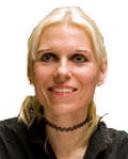Psychopathy
What Do Heroes and Psychopaths Have in Common?
A closer look at fearless heroes, successful psychopaths, and callous criminals.
Posted June 14, 2022 Reviewed by Michelle Quirk
Key points
- Ted Bundy, Clyde Barrow, Bernie Madoff, and Chuck Yeager have been described in the psychopathy literature as sharing core psychopathic traits.
- While Barrow, Bundy, and Madoff were notorious psychopathic criminals, Yeager was a successful Air Force test pilot.
- The affectionless, unsympathetic CEO or the charming, egocentric celebrity may ultimately be a better fit for the role of successful psychopath.

Ted Bundy, Clyde Barrow, Bernie Madoff, and Chuck Yeager have repeatedly been described in the psychopathy literature as embodying core psychopathic traits.7,8,9,10,13 At first glance, this comparison seems bizarre, as these four figures embarked on very different "career paths."
Ted Bundy
One of the most notorious serial killers in history, Ted Bundy abducted, raped, and murdered between 30 and 100 young women and girls during the 1970s and possibly earlier.
His signature murders followed a specific modus operandi: using his superficial charm and feigning physical injury or impersonating an authority figure, Bundy would make his victims follow him to his car. Here, he would incapacitate them with a blow to the head and drive them to a secondary location, where he would sexually abuse and strangulate them.
Bundy was also a necrophile, often revisiting the corpses of his victims to engage in sexual activity with them. In some cases, he decapitated his victims and kept their heads as trophies.
Clyde Barrow
Immortalized in the 1967 film Bonnie and Clyde, Clyde Barrow and his girlfriend, Bonnie Parker, robbed banks, grocery stores, gas stations, and funeral homes in the central states during the Great Depression.
During their robbery spree, which lasted two years, the couple murdered at least nine police officers and four civilians until they were shot dead in 1934.
While Barrow had a criminal record before meeting Parker, their violent rampage began after Barrow had been imprisoned for auto theft in Eastham Prison, Texas. His stated motive was to collect enough money to launch a raid on Eastham Prison, avenging the sexual assault he had endured while incarcerated.
Bernie Madoff
Bernie Madoff was a con man who carried out the largest Ponzi scheme in history, defrauding thousands of investors of billions of dollars from at least as early as the 1990s and until his arrest in 2008.
Promising large, steady gains, Madoff would attract investors to deposit funds into his investment firm. He publicly claimed to use a legal trading strategy known as split-strike conversion to make profits for his clients.
In reality, he deposited investors' funds into a single bank account and paid gains to existing investors using capital from new investors.
Madoff's fraudulent scheme started to flounder at the onset of the financial crisis in 2008, and he confessed to his sons, who turned him in to the authorities. At the time of his arrest, his bank account contained $64.8 billion in client assets.
Chuck Yeager

Unlike Bundy, Barrow, and Madoff, Chuck Yeager wasn't a criminal offender but a highly successful Air Force general and record-setting experimental test pilot.
A fighter ace in World War II, Yeager shot down 13 German fighter jets and five in a single day.
Despite a long-standing scientific claim that any plane flying faster than the speed of sound would be torn to pieces by shock waves, Yeager set out to break the sound barrier in 1947.
Yeager's record-breaking achievement began with him climbing out of a B-29 bomber at an altitude of 23,000 feet and entering the cockpit of an experimental rocket-powered, high-speed aircraft. After getting to 43,000 feet, he reached a speed of 700 miles an hour, becoming the first in the world to exceed the speed of sound in level flight.
Thanks to Tom Wolfe's 1979 book, The Right Stuff, Yeager came to exemplify the heroic aviator, who was made of the "right stuff"—embodying the physical and psychological characteristics needed to take on the enormous risk required of pilots and astronauts involved in U.S. postwar aviation experiments.
The 1983 film The Right Stuff based on the book and starring the real Chuck Yeager lent inspiration to the Maverick character in the 1986 motion picture Top Gun.
Successful Vs. Criminal Psychopaths
Despite never engaging in callous, manipulative, or deceptive behaviors, Yeager has been described as embodying core psychopathic traits much like Bundy, Barrow, and Madoff.
From a young age, Yeager exhibited a high degree of fearlessness—a trait that is essential to succeeding as an Air Force experimental test pilot. Interestingly, that same trait has been identified as a basis for psychopathy, making the death-defying hero and the psychopathic criminal two of a kind.1,9,10,11 As Lykken (1982) put it:
The hero and the psychopath are twigs from the same branch. Both are relatively fearless. (p. 22)
Lykken went on to suggest that if Yeager had had different childhood experiences or opportunities, he might have committed crimes rather than breaking the sound barrier in an experimental jet.
To be sure, the claim here is not that heroes like Yeager or Maverick suffer from pathological psychopathy like Bundy, Barrow, and Madoff. The latter belong to a group of antisocial psychopaths whose psychopathic traits merit a clinical diagnosis of a cluster B personality disorder, as classified by the fifth edition of the Diagnostic and Statistical Manual of Mental Disorders (DSM-5).2,3,4
The cluster B personality disorders—or the dramatic, emotional, and erratic cluster—encompass narcissistic personality disorder, histrionic personality disorder, borderline personality disorder, and antisocial personality disorder.
One possibility, however, is that fearless heroes like Yeager or Maverick are successful psychopaths3—also known as noncriminal, subclinical, or socialized psychopaths.2,12,13
The idea of the successful psychopath dates back to Cleckley's (1941) book, The Mask of Sanity. According to Cleckley, the successful psychopath embodies key psychopathic traits yet falls short of meeting the threshold for clinical diagnosis, which is to say that successful psychopathy is a subclinical condition or "syndrome," not a clinical psychopathology. Cleckley's successful psychopath furthermore has no criminal record to speak of and may even hold a noteworthy job thanks to the usefulness of their psychopathic traits.
However, the suggestion that fearlessness grounds psychopathy remains highly controversial,4,5,6 as does the idea that death-defying heroes like Yeager or Maverick are good examples of successful psychopaths.
Certainly, fearless heroes like Yeager or Maverick are not the best examples of successful psychopaths in Cleckley's sense. While the thought that there are both good and evil psychopaths has intuitive appeal, the affectionless, unsympathetic CEO or the charming, egocentric media personality seems a better fit for the role of successful psychopath.
Indeed, as we will see in the next post, a new study provides evidence against the idea that there is any interesting overlap between traits indicative of fearless heroism and those suggestive of successful psychopathy.4
References
[1] Brinkley, C. A., Newman, J. P., Widiger, T. A., & Lynam, D. R. (2004). Two approaches to parsing the heterogeneity of psychopathy. Clinical Psychology: Science and Practice, 11(1), 69–94.
[2] Brogaard, B. (2020). Hatred: Understanding our most dangerous emotion. Oxford University Press.
[3] Cleckley, H. (1941). The mask of sanity. Mosby
[4] Crego, C., & Widiger, T. A. (2022). Core Traits of Psychopathy. Personality Disorders: Theory, Research, and Treatment. Advance online publication. http://dx.doi.org/10.1037/per0000550
[5] Hare, R. D. (1980). A research scale for the assessment of psychopathy in criminal populations. Personality and Individual Differences, 1(2), 111–119.
[6] Hare, R. D. (1991). The hare psychopathy checklist-revised manual. MultiHealth Systems.
[7] Hare, R. D. (1993). Without conscience. The disturbing world of the psychopaths among us. Pocket Books.
[8] Kael, P. (1967). Bonnie and Clyde. The New Yorker, 21, 147–148.
[9] Lykken, D. T. (1982). Fearlessness: Its carefree charm and deadly risks. Psychology Today, September, 20–28.
[10] Lykken, D. T. (1995). The antisocial personalities. Erlbaum.
[11] Malterer, M. B., Lilienfeld, S. O., Neumann, C. S., & Newman, J. P. (2010). Concurrent validity of the Psychopathic Personality Inventory with offender and community samples. Assessment, 17(1), 3–15.
[12] Romero, J. M. P., Manso, J. M. M., Alonso, M. B., & Sánchez, M. E. G.-B. (2013). Socialized/subclinical psychopaths in intimate partner relationships: Profile, psychological abuse and risk factors. Papeles del Psicólogo, 34(1), 32-48.
[13] Smith, S. F., Watts, A., & Lilienfeld, S. (2014). On the trail of the elusive successful psychopath. The Psychologist, 27(7), 506–511.
[14] Wolfe, T. (1979). The right stuff. Farrar, Straus & Giroux.




